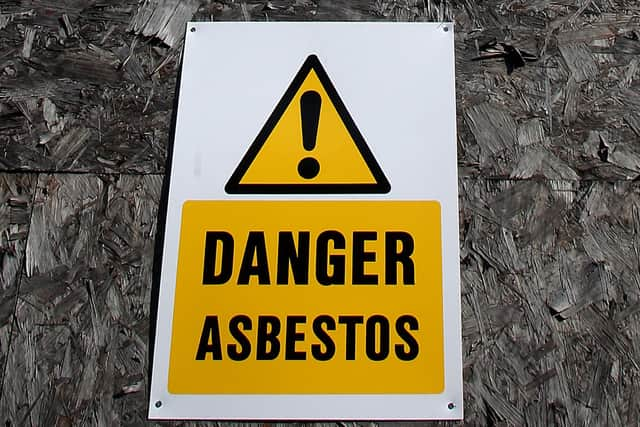More than 150 schools in Glasgow contain asbestos somewhere within the structure
and live on Freeview channel 276
An investigation by law firm Irwin Mitchell has found that over 150 schools in Glasgow contain asbestos.
The inquiry, conducted by submitting Freedom of Information requests to 20 of the UK’s most highly populated council areas, found that more than 4,5000 public buildings in the UK still contain asbestos - including over 150 schools in the city of Glasgow.
Advertisement
Hide AdAdvertisement
Hide AdIwin Mitchell conducted the research to showcase how widespread the use of asbestos is in public buildings, the carcinogen most commonly used for cladding in construction throughout the 20th century. Exposure to asbestos has been linked to later cases of mesothelioma (a terminal cancer on the lining of the lungs) or abestosis (a chronic lung disease).
While Glasgow City Council was unable to supply data on the total number of buildings containing asbestos, saying to do so would ‘incur unreasonable costs’, but did report that 159 schools did contain the substance, made up of 96 primary, 18 secondary and 45 nursery schools in the city.
The council also reported that an average of 261 asbestos surveys carried out over the last five years.
In 2017 there 310 surveys for asbestos between 2017/18, 342 between 2018/19, 334 between 2019/20, 118 between 2020/21 and 200 between 2021/22.
Advertisement
Hide AdAdvertisement
Hide AdIn April 2022, MPs recommended a 40-year deadline be set for the removal of asbestos from the estimated 300,000 public and commercial buildings in Britain that still contain it. However, the report from the Work and Pensions Committee was rejected by the government.
Following the announcement, Irwin Mitchell contacted 20 local authorities in the UK to gain an insight into the true picture of asbestos in public buildings.
In response to requests submitted by law firm Irwin Mitchell under Freedom of Information Act (FOI), it was revealed that 4,533 public buildings across the 20 councils – ranging from as far north as Glasgow to as far south as Cornwall – still contain asbestos, averaging at around 225 buildings per local authority.
Schools are the largest category of buildings affected, making up almost a quarter of the total number. This is followed by the likes of community centres, agricultural and park buildings, office space, libraries, leisure facilities and residential settings.
Advertisement
Hide AdAdvertisement
Hide AdThe legal experts believe if the data provided is repeated around the country, it’s estimated that across the 387 local authorities in England, Scotland and Wales combined, there are around 87,000 public buildings containing asbestos.
The figures also show that only 291 buildings across the 20 local authorities in question had asbestos removed from them in the last five years, but that 3,263 had had a survey undertaken within the same timeframe.
The legal experts further estimate that if removals continued at the current rate, only around 2,300 of the 4,500 buildings across the 20 councils would have asbestos removed within the next 40 years, the recommended deadline. As a result of the calculation, it would mean the speed of the removal process would need to be doubled to meet the requirement.
Adrian Budgen, a leading specialist asbestos-related disease lawyer at Irwin Mitchell, said: “Most people associate asbestos with historical exposure in factories or construction work, but these latest figures highlight the extensive risk still posed by the deadly substance across the UK in everyday buildings used by the public.
Advertisement
Hide AdAdvertisement
Hide Ad“At Irwin Mitchell, sadly, we come across families and individuals affected by asbestos most often after coming into contact with it in their workplace, and to have it confirmed that it’s not yet been eradicated from a large number of public buildings is incredibly concerning.
“One of the main problem areas is revealed to be schools, which are obviously densely populated with pupils, teachers and other school workers for long hours at a time. It’s extremely worrying that so many still contain asbestos, essentially putting children at risk every day.
“Whilst some of the asbestos may not yet be deemed harmful, once it’s disturbed or in a state of disrepair it can quickly become very dangerous, and with many of our public buildings being old and maintenance budgets being stretched, it’s a huge concern.”


Traditionally, people such as factory and construction workers, carriage and ship-builders, plasterers, electricians and plumbers were most exposed to asbestos but, over the past 20 years, there has been an increasing number of people developing asbestos-related illnesses from more indirect sources such as family members washing work clothes covered in asbestos dust or non-industrial exposure.
Advertisement
Hide AdAdvertisement
Hide AdAdrian added: “The data collated from our FOI requests demonstrate that asbestos remains a clear and present danger. It was therefore deeply disappointing that the call put forward last April, for a 40-year deadline for its removal, was rejected. While we understand the logistical and financial scale of the challenge of removing it safely, it’s inherently dangerous and simply can’t be left in situ.
“We’ve known the dangers of asbestos for several decades now, with its use outlawed for more than 20 years, yet there’s still an ongoing debate around whether to remove it from our schools. It’s also very concerning that our estimations suggest that the 40 year deadline previously recommended wouldn’t be enough time for all removals to be undertaken given the current pace.
“More needs to be done to help protect people and we call on the Government to approve the recommendations of the Select Committee Report, accelerate the removal process and ensure asbestos is extracted from all public buildings within the given timeframe – or preferably sooner.”
Comment Guidelines
National World encourages reader discussion on our stories. User feedback, insights and back-and-forth exchanges add a rich layer of context to reporting. Please review our Community Guidelines before commenting.
